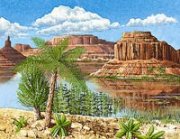
Worksheets and No Prep Teaching Resources
Reading Comprehension Worksheets
Earth Science

Earth Science
 Worksheets and No Prep Teaching Resources Reading Comprehension Worksheets Earth Science |
 Earth Science |
| edHelper's suggested reading level: | grades 9 to 10 | |
| Flesch-Kincaid grade level: | 9.72 |
|
Earth Time - Precambrian Time and the Paleozoic Era
By Trista L. Pollard |

|
 1 The grass leaves, and twigs you step on today will be studied by a paleontologist thousands, maybe millions of years from now. These specimens in our yards and on our sidewalks provide the clue to the environmental changes that occur on our planet. They tell about the changes in climate, the organisms that lived on the planet, and the areas of water that existed during a specific time. When scientists study fossils, they are interested in the evolution of organisms.
1 The grass leaves, and twigs you step on today will be studied by a paleontologist thousands, maybe millions of years from now. These specimens in our yards and on our sidewalks provide the clue to the environmental changes that occur on our planet. They tell about the changes in climate, the organisms that lived on the planet, and the areas of water that existed during a specific time. When scientists study fossils, they are interested in the evolution of organisms. |
Create Weekly Reading Books
Prepare for an entire week at once! |
| Leave your feedback on Earth Time - Precambrian Time and the Paleozoic Era (use this link if you found an error in the story) |
 |
Earth Science
|
 |
High School Reading Comprehensions and High School Reading Lessons
|